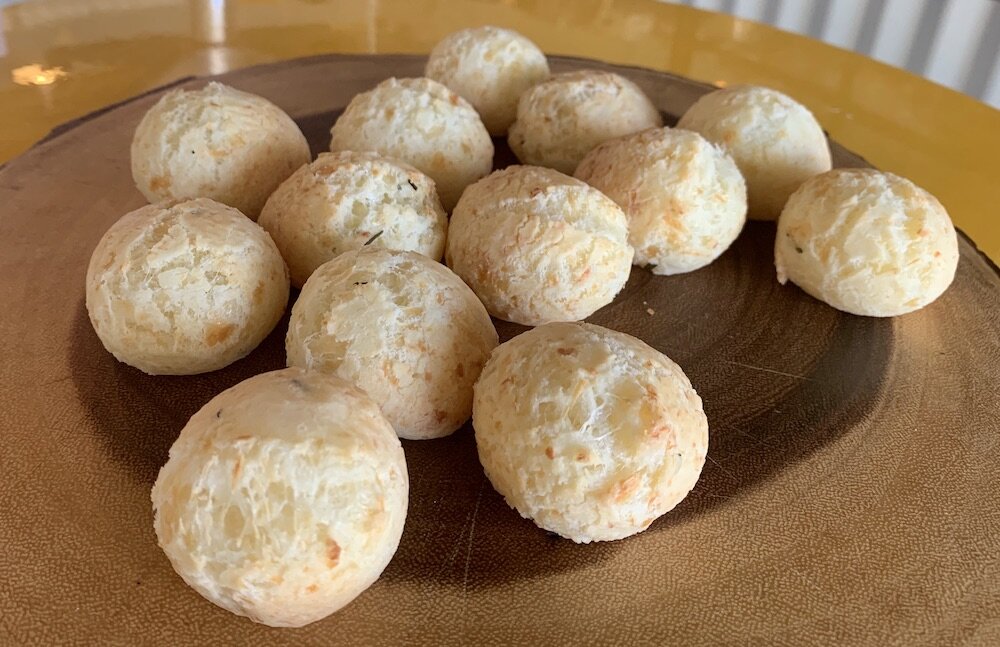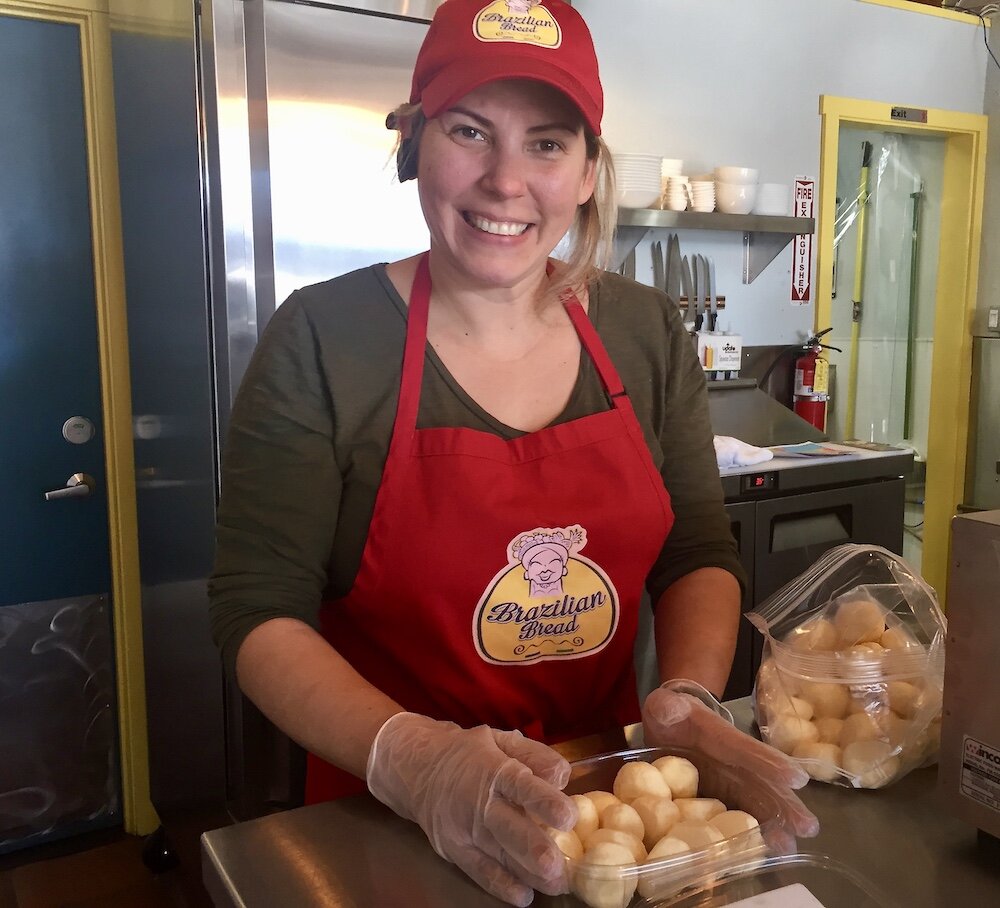Pão de Queijo: Brazilian Cheese Ball Obsession
A bevy of cheese balls photo credit Anna Mindess
Attend almost any party in Brazil, and you’ll discover that the most popular guests are warm, cheesy orbs, crispy on the outside, moist and chewy on the inside. Pão de queijo (cheese bread) is woven into daily life, as a companion to the morning cup of coffee, then baked fresh all day long at stands, shops, bakeries, markets, and restaurants. No wonder it is one of the first things Brazilian emigrants miss when they leave the country.
Sarita Blum, a digital artist from Rio de Janeiro, moved to the US in 2008. “When I was growing up in Rio,” she says, “pão de queijo was a symbol of hospitality, a sign of welcome, part of a Sunday brunch served with strong sweet coffee or brought to us at a restaurant table with a bowl of olives before ordering. It is a necessity for birthdays, weddings, and other parties.” It was such an important part of Blum’s life, that before she moved to California, she did research to locate Brazilian markets in her new home where she could find the ingredients to make them herself.
The petite, puffy balls can contain a variety of cheeses, but the classic one hails from the Brazilian state of Minas Gerais. Minas is renowned for its gastronomy, hospitality, rolling hills, green pastures, and the big farms which produce several handmade cheeses from raw cow’s milk. Frescal is the soft, salty, fresh cheese that is most commonly used in pão de queijo. However, the main ingredient in pão de queijo is not cheese. It is tapioca, the extracted starch of the cassava plant, a hardy tuber also known as manioc or yuca. Other ingredients include milk, eggs and salt. Containing no yeast, the cheesy balls are only good the day they are baked and best eaten warm right out of the oven.
Garlic Rosemary Cheese Balls photo credit Katarina Monier
While most Brazilians are munching their daily pão de queijo, they are probably unaware that the little golden spheres reflect an amalgam of their country’s history. Cassava provided one of the staple foods for the millions of Indigenous Brazilians, the land’s original inhabitants. The plant is drought-resistant and comparatively easy to grow. When the Portuguese arrived in Brazil around 1500, the country’s natives were already preparing soups and stews with cassava starch, which they called tipi’óka, the Tupi word which became ‘tapioca.’ Portuguese colonizers brought with them a strong European fondness for wheat breads and pastries, however, they discovered that wheat would not grow easily in the hot Brazilian climate and it was too expensive to import from home. In time, tapioca starch would make breadstuffs to replace their beloved wheat.
Lonely Planet’s book, Best Brunches, adds a disturbing facet to the chronicle of cheese balls’ origins. “Like so many of Brazil’s culinary staples, pao de queijo’s speculated history harkens back to the slave trade. As far back as the 1600s, [African] slaves were producing manioc starch for farmers in the Brazilian state of Minas Gerais. In order to remove the toxic residual cyanide from the root, manioc must be processed (peeled, grated, soaked in water and dried). Resourceful by necessity, slaves scraped away the leftover manioc starch, rolled it into balls and baked it.”
Later, when gold mining decreased in Minas Gerais (minas means mines), the Portuguese brought over cows and set up large dairy farms in the same locale. This led to the special Minas cheeses and cheese balls that are consumed daily throughout the country today. “An important part of Brazil’s culinary heritage,” says Sarita Blum, “is its three roots: Native people, Africans and the Portuguese. Each one contributed different flavors and dishes that make up a rich and special cuisine.”
Delvira Rodrigues photo credit Anna Mindess
Delvira Rodrigues was interested in a different aspect of history, while preparing to open her Brazilian Breads business in Northern California in 2015. ‘How did Brazilian cheese balls arrive in the US?’ she wondered. She discovered that the first wave of Brazilian immigrants, who were mostly construction workers, moved to towns around Boston in the 1960’s. And when they missed their pão de queijo, they figured out how to make do with different cheeses (parmesan is a likely substitute). In the late 1980’s, Miami attracted a different group of Brazilians: artists, businesspeople and professionals. Both groups of immigrants experienced cheese-bread-withdrawal and always begged visitors from their homeland to bring them some tapioca flour.
Rodrigues had moved to Northern California from Brazil in 2009. When her family missed their daily pão de queijo, they asked her to bake some, as she had enjoyed cooking since she was a girl. Rodrigues scoured the local shops for the right ingredients, but because they were imported from Brazil, the price was prohibitive and the taste wasn’t always the best. So, she experimented. It took her five years to develop her own recipes for pão de queijo using locally sourced ingredients. She ended up using a blend of cotija and parmesan cheeses. When she shared her creations, a friend from Mexico suggested adding jalapeños. Rodrigues took the hint and the result was a hit. She wondered what else she could add and tried bacon. Another hit.
The classic Brazilian dessert Romeu e Julieta (Romeo and Juliet), which pairs a slice of white cheese with a slab of guava paste, inspired Rodrigues to create a cheese ball whose center is filled with guava jam. When the ball is baked, its middle becomes molten and the guava often trickles alluringly over the top.
After finding fans while catering numerous parties, music festivals and other events, in 2018, Rodrigues opened Brazilian Bread Café.
in North Berkeley to serve her cheese balls and other standbys of Brazilian fare. She added a second café in San Rafael in 2020.
One natural audience for the golden rolls with the crunchy crust is the growing number of people who eat gluten-free by choice or necessity. Pão de queijo has always been naturally gluten-free thanks to its cassava flour, but that side-benefit did not attract as specific a following in Brazil as it does in the US.
For those who want to bake their cheese balls at home, there’s Brazi Bites, a nationwide company started by Junea Rocha, another Brazilian who was homesick for these cheesy treats. Her Portland-based enterprise features four flavors, including three-cheese pizza and cinnamon churro. Brazi Bites are sold in freezer cases across the country, in national chains like Target, Costco and Whole Foods, as well as local markets.



